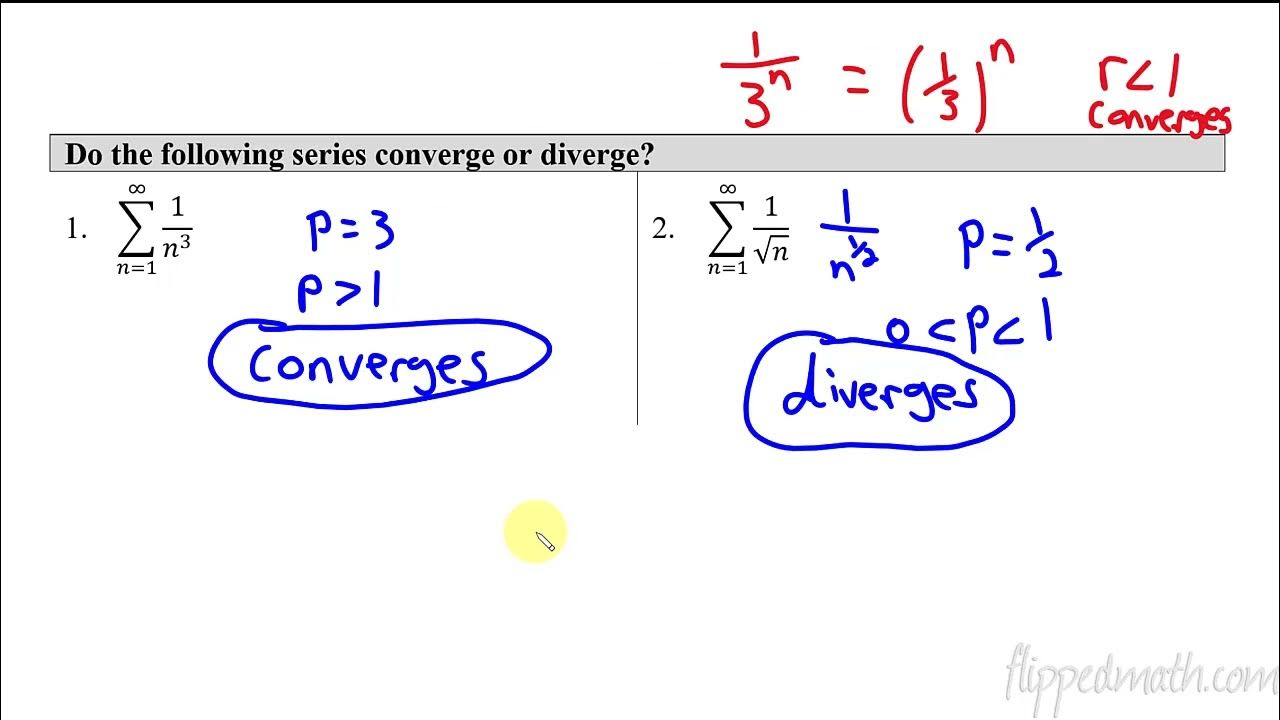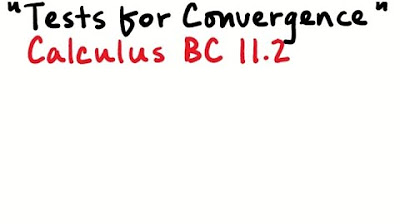AP Calculus BC Lesson 10.5
TLDRThis video script delves into the concepts of p-series and harmonic series, explaining their convergence and divergence based on the value of p. It clarifies that a p-series converges if p > 1 and diverges if p ≤ 1, using examples to illustrate the integral and series tests. The script also distinguishes between p-series and harmonic series, highlighting the divergence of the latter despite p being equal to 1. Additionally, it addresses the convergence of geometric series and applies the nth term and integral tests to various series, providing a comprehensive understanding of infinite series behavior.
Takeaways
- 📚 The lesson focuses on P-series and harmonic series, which are specific types of infinite series.
- 🔢 A P-series is an infinite series of the form 1/n^P, where P is a positive number.
- 📈 The convergence or divergence of a P-series is determined by the value of P: it converges if P > 1 and diverges if P ≤ 1, based on the integral test.
- 🌐 The integral test implies that the behavior of a P-series is analogous to that of the corresponding improper integral.
- 🌰 Examples are provided to illustrate the convergence or divergence of series with different values of P, such as 1/n^5 (converges) and 1/n^0.2 (diverges).
- 🔍 The concept of a harmonic series is introduced as a special case of a P-series where P = 1, and it is shown to diverge.
- 📊 The script includes a detailed analysis of various series, applying the nth term test, geometric series rules, and the integral test to determine convergence.
- 🤔 The nth term test is inconclusive for certain series, requiring additional tests like the integral test for a definitive conclusion.
- 📂 The integral test is used to compare the series to an integral that converges, thus confirming the convergence of the series if the integral converges.
- 🔑 The values of P that allow for the convergence of both the P-series and the harmonic series are explored, with the conclusion that P must be greater than 1/2 but less than 4.
- 📝 The lesson concludes with a clear set of conditions for P that ensure the convergence of the given series.
Q & A
What is a P-series in the context of infinite series?
-A P-series is a specific type of infinite series with the format Σ from n=1 to Infinity of 1/(n^p), where p is a positive number.
How does the Integral Test relate to the convergence of a P-series?
-The Integral Test states that an integral and a series will converge or diverge together. Since the integral of 1/x^p converges for p > 1 and diverges for p ≤ 1, the same behavior applies to the P-series.
What is the condition for a P-series to converge?
-A P-series converges if p, the exponent, is greater than 1. If p is less than or equal to 1, the series diverges.
What is a harmonic series and how does it behave?
-A harmonic series is a special type of P-series where p equals 1. It diverges because, according to the convergence condition, a series diverges when p is less than or equal to 1.
How can you determine the convergence or divergence of the series Σ from n=1 to Infinity of 1/n^5?
-Since p equals 5 in this series, which is greater than 1, the series converges according to the P-series convergence condition.
What is the behavior of the series Σ from n=1 to Infinity of 1/n^0.2?
-The series diverges because p equals 0.2, which is less than or equal to 1, indicating divergence based on the P-series convergence rule.
What happens with the series Σ from n=1 to Infinity of 1/(n^(1/3))?
-This series diverges because p equals 1/3, which is less than or equal to 1, leading to divergence according to the P-series convergence criteria.
How does the nth term test work for determining the convergence of a series?
-The nth term test checks if the limit of the nth term of the series approaches Infinity as n also approaches Infinity. If the limit is zero, the test is inconclusive; it does not confirm convergence or divergence.
What is the condition for the convergence of the geometric series Σ from n=1 to Infinity of (e^n)/(2^n)?
-The geometric series converges if the absolute value of the common ratio r is less than 1. In this case, r is e/2, and since e is approximately 2.7, the series converges because e/2 is less than 1.
How can you determine if the series Σ from n=1 to Infinity of n^(-e) converges?
-Since e is approximately 2.7, the series can be rewritten as 1/n^e. The series converges because e is greater than 1, ensuring that the terms of the series approach zero as n increases.
What values of P make both the series Σ from n=1 to Infinity of P^n/(4^n) and the series Σ from n=1 to Infinity of 1/(n^(2P))) converge?
-For both series to converge, P must be greater than 1/2 but less than 4. This is because the exponent 2P in the first series must be greater than 1 for convergence, and for the second series, P must be less than 4 to ensure the absolute value of the term 1/(4^n) is less than 1.
Outlines
📚 Introduction to P-Series and Harmonic Series
This paragraph introduces the concept of P-series and harmonic series in the context of infinite series. A P-series is defined as an infinite series of the form ∑ from n=1 to ∞ of 1/n^p, where p is a positive number. The convergence or divergence of these series is linked to the value of p, with the series converging if p > 1 and diverging if p ≤ 1. This is based on the integral test, which was discussed in a previous lesson. The paragraph provides examples to illustrate the convergence and divergence of P-series based on the value of p, such as a series with p=5 (convergent) and p=0.2 (divergent). It also introduces the concept of a harmonic series, which is a special case of a P-series with p=1 and is known to diverge.
🔍 Analyzing Convergence and Divergence of Infinite Series
This paragraph delves into the analysis of whether various infinite series converge or diverge. It discusses the convergence of a series with a cubic term (1/n^3) and the divergence of the harmonic series (1/n). The paragraph also addresses a series with a negative exponent (1/n^(-negative e)) and explains that it converges because the exponent e is greater than 1. The discussion continues with the identification of a convergent geometric series (1/3^n) and the application of the nth term test and integral test to determine the convergence of other series, such as 1/(n+2)^2 and e^n/(2^n). The paragraph concludes with the determination that only the first series (1/(n+2)^2) converges.
🔢 Finding Values of P for Convergent Series
The focus of this paragraph is on identifying the values of P for which two given series converge. The first series is a P-series of the form P^n/(4^n * (n+1)^p), and the second is a harmonic series modified by a factor of 1/(n^2 * P). To ensure convergence for the P-series, the exponent 2p must be greater than 1, leading to the conclusion that P must be greater than 0.5. For the harmonic series to converge, the value of P must be between -4 and 4, but since P must also be greater than 0.5, the final condition is that P must be between 0.5 and 4. The paragraph concludes that the correct answer is Choice A, which states P is between 0.5 and 4.
Mindmap
Keywords
💡P series
💡Harmonic series
💡Convergence
💡Divergence
💡Integral test
💡Improper integrals
💡Geometric series
💡Nth term test
💡Limit
💡Derivative
💡Monotonicity
Highlights
Exploration of P series and harmonic series in lesson 10.5.
P series is an infinite series of the format 1/n^P, where P is a positive number.
The convergence of P series is related to improper integrals, as covered in lesson 6.13.
The integral test indicates that P series converges if P > 1 and diverges if P ≤ 1.
Examples provided to determine the convergence or divergence of various P series.
The series 1/n^5 converges because P (5) is greater than one.
The series 1/n^0.2 diverges as P (0.2) is less than or equal to one.
The series 1/(n^(1/3)) diverges because P (1/3) is less than or equal to one.
The series 1/(n^(3/2)) diverges as it simplifies to 1/√n, with P (1/2) being less than or equal to one.
The series 1/n^e converges because P (e) is greater than one.
The harmonic series, a special P series with P = 1, always diverges.
The convergence or divergence of infinite series is determined by specific tests, such as the P series test and the integral test.
The series 1/n^3 converges, as P (3) is greater than one.
The series 1/n diverges as it is the harmonic series with P = 1.
The series 1/n^(-π) converges because P (-π) is greater than one.
The series 1/(3^n) is a convergent geometric series as the absolute value of its common ratio (1/3) is less than one.
The series 1/(n + 2)^2 does not converge based on the nth term test, but the integral test can be applied for further analysis.
The series 1/(n^(1/4)) does not converge as P (1/4) is less than or equal to one.
For the series 1/(n^P) and 1/(n^(2P)), both converge if P > 1/2 and P < 4.
The value of P for convergence in the given series is between 1/2 and 4, exclusive.
Transcripts
Browse More Related Video

Calculus BC – 10.5 Harmonic Series and p-series

Proof of p-series convergence criteria | Series | AP Calculus BC | Khan Academy

Integral Test and p-Series

Calculus 2 - Geometric Series, P-Series, Ratio Test, Root Test, Alternating Series, Integral Test

Tests for Convergence

Unit 10 Study Guide - AP Calculus (BC Only)
5.0 / 5 (0 votes)
Thanks for rating: